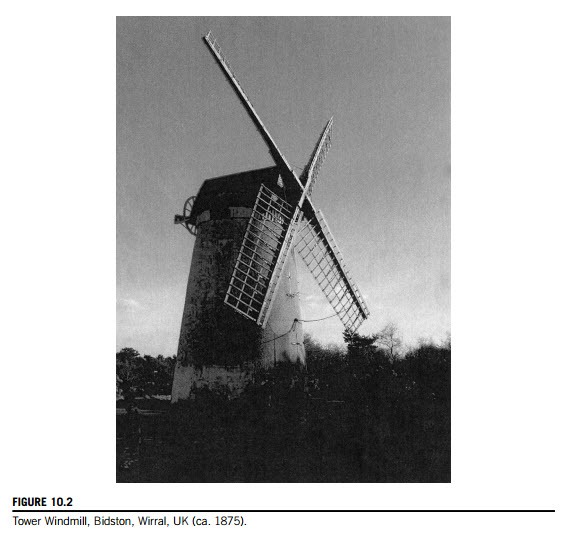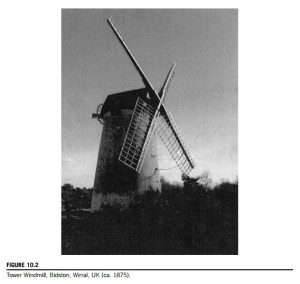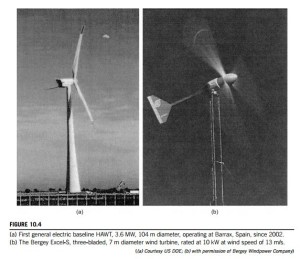Types of wind turbine
Wind turbines fall into two main categories: those that depend upon aerodynamic drag to drive them (i.e., the old style windmills) and those that depend upon aerodynamic lift. Drag machines such as those developed in ancient times by the Persians were of very low efficiency compared with modern turbines (employing lift forces) and so are not considered any further in this chapter.
The design of the modern wind turbine is based upon aerodynamic principles, which are elaborated later in this chapter. The rotor blades are designed to interact with the oncoming airflow so that an aerodynamic lift force is developed. A drag force is also developed but, in the normal range
of prestall operation, this will amount to only about 1% or 2% of the lift force. The lift force, and the consequent positive torque produced, drives the turbine thereby developing output power.
In this chapter, the focus of attention is necessarily restricted to the aerodynamic analysis of the horizontal axis wind turbine (HAWT) although some mention is given of the vertical axis wind turbine (VAWT). The VAWT, also referred to as the Darrieus turbine after its French inventor in the 1920s, uses vertical and often slightly curved symmetrical aerofoils. Figure 10.3(a) shows a general view of the very large 4.2 MW vertical axis Darrieus wind turbine called the Eole’ VAWT installed at Cap-Chat, Quebec, Canada, having an effective diameter of 64 m and a blade height of 96 m.
Figure 10.3(b), from Richards (1987), is a sketch of the major components of this aptly named eggbeater wind turbine. Guy cables (not shown) are required to maintain the turbine erect. This type of machine has one distinct advantage: it can operate consistently without regard to wind direction. However, it does have a number of major disadvantages:
i. wind speeds are low close to the ground so that the lower part of the rotor is rather less productive than the upper part;
ii. high fluctuations in torque occur with every revolution;
iii. negligible self-start capability;
iv. limited capacity for speed regulation in winds of high speed.
Darrieus turbines usually require mechanical power input to start them but have been known to self-start. (Several VAWTs have been destroyed by such self-starts.) For assisted starting, the method used is to run the generator as a motor up to a speed when aerodynamic wind forces can take over. Stopping a VAWT in high winds is difficult as aerodynamic braking has not been successful and friction braking is needed.
According to Ackermann and So¨der (2002), VAWTs were developed and produced commercially in the 1970s until the 1980s. Since the end of the 1980s, research and development on VAWTs has virtually ceased in most countries, apart from Canada (see Gasch, 2002; Walker & Jenkins, 1997; Divone, 1998).
Large HAWTs
The HAWT type is currently dominant in all large-scale applications for extracting power from the wind and seems likely to remain so. The large HAWT, Figure 10.4(a), operating at Barrax, Spain, is 104 m in diameter and can generate 3.6 MW. (This size of wind turbine has become fairly commonplace, especially in the coastal waters around Great Britain.) Basically, a HAWT comprises a nacelle mounted on top of a high tower, containing a generator and, usually, a gearbox to which the rotor is attached. Increasing numbers of wind turbines do not have gearboxes but use a direct drive. A powered yaw system is used to turn the turbine so that it faces into the wind. Sensors monitor the wind direction and the nacelle is turned according to some integrated average wind direction. The number of rotor blades employed depends on the purpose of the wind turbine. As a rule, three-bladed rotors are used for the generation of electricity. Wind turbines with only two or three blades have a high ratio of blade tip speed to axial flow velocity (the tip-speed ratio), but only a
low starting torque and may even require assistance at startup to bring it into the useful power pro- ducing range of operation. Commercial turbines range in capacity from a few hundred kilowatts to more than 3 MW. The crucial parameter is the diameter of the rotor blades, the longer the blades, the greater is the “swept” area and the greater the possible power output. Rotor diameters now range to over 100 m. The trend has been toward larger machines as they can produce electricity at a lower price. Most wind turbines of European origin are made to operate upwind of the tower, i.e., they face into the wind with the nacelle and tower downstream. However, there are also wind turbines of downwind design, where the wind passes the tower before reaching the rotor blades. Advantages of the upwind design are that there is little or no tower “shadow” effect and lower noise level than the downwind design.
Small HAWTs
Small wind turbines with a horizontal axis were developed in the nineteenth century for mechanical pumping of water, e.g., the American farm pump. The rotors had 20 or more blades, a low tip-speed ratio but a high starting torque. With increasing wind speed pumping would then start automatically. According to Baker (1985), the outgrowth of the utility grid caused the decline of the wind-driven pump in the 1930s. However, there has been a worldwide revival of interest in small HAWTs of modern design for providing electricity in remote homes and isolated communities that are “off grid.” The power output of such a wind-powered unit would range from about 1 to 50 kW. Figure 10.4(b) shows the Bergey Excel-S, which is a three-blade upwind turbine rated at 10 kW at a wind speed of 13 m/s. This is currently America’s most popular residential and small business wind turbine.
Effect of tower height
An important factor in the design of HAWTs is the tower height. The wind speed is higher the greater the height above the ground. This is the meteorological phenomenon known as wind shear. This common characteristic of wind can be used to advantage by employing wind towers with increased hub heights to capture more wind energy. A study by Livingston and Anderson (2004) investigated the wind velocities at heights up to 125 m on the Great Plains (United States) and pro- vide a compelling case for operating wind turbines with hub heights of at least 80 m. Typically, for daytime temperatures, the variation follows the wind profile one-seventh power law (i.e., wind speed increases proportionally to the one-seventh root of height above the surface):
where cx is the wind speed at height h, cx,ref is the known wind speed at a reference height href. The exponent n is an empirically derived coefficient. In a neutrally stable atmosphere and over open ground (the normal condition), n 1/7 or 0.143. Over open water, a more appropriate coefficient is n 0.11. As an example, it is required to estimate the wind speed at a height of 80 m above the ground using a reference velocity of 15 m/s measured at a hub height of 50 m:
Even a small increase in wind speed can be important. It is shown later that the possible power extracted from the wind varies as the cube of the wind speed. Using this example, the increase in the power extracted would be over 22% as a result of increasing the hub height from 50 to 80 m. Of course, there is a penalty as costs will be greater for the stronger tower structure required.



